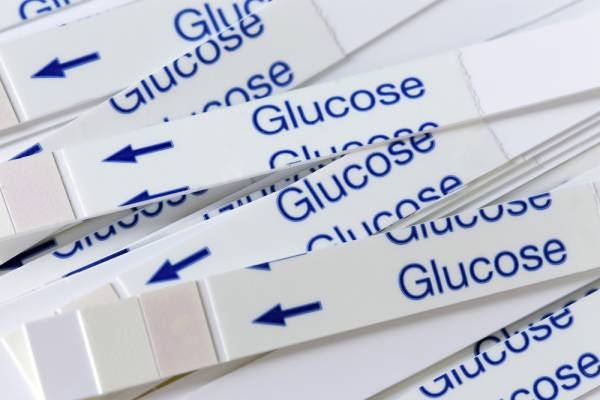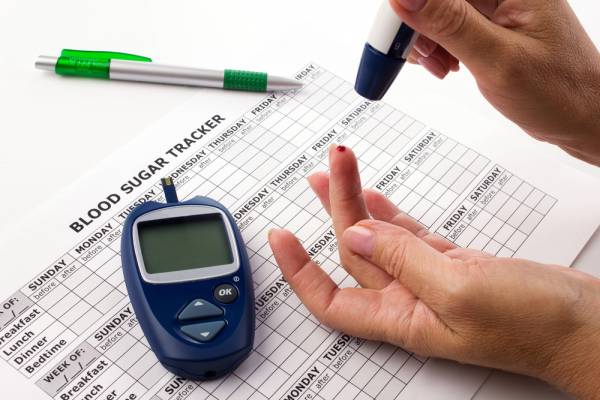Impairment of blood glucose control can indicate anything from serious alterations of normal physiology like diabetes, or in its early and milder stages, an overconsumption of carbohydrates and a decrease in the cells’ sensitivity to insulin.
But how do you know how well this system works or if you are at risk and need to make some lifestyle modifications? Luckily there is a relatively simple way to gauge your insulin sensitivity, as well as measure your ability to properly handle spikes in blood glucose.
It’s called the oral glucose tolerance test and here’s what you need to know about it.
RELATED: The Effects of Exercise Intensity on Insulin Control
The Relationship Between Insulin and Blood Glucose
First, let’s revisit the basic relationship between insulin and blood glucose. Carbohydrates are broken down into simple sugars, like glucose, and released into the circulation. Proper glucose control is crucial for cognitive function and general well being.
Glucose cannot pass from the circulation to the cell unless it receives the correct signal from the hormone insulin. This process can be negatively impacted by disease, poor dietary habits, or environmental factors.
A decrease in the efficacy of this system should be a major health concern. When glucose builds up to a high enough level it becomes damaging to small capillaries and impairs the exchange of nutrients and oxygen from the blood to your tissues.
RELATED: Magnesium Helps Balance Blood Sugar and Lower Insulin
The Oral Glucose Tolerance Test
The oral glucose tolerance test (OGTT) is commonly associated with diabetic screening and early detection. However, even if you feel you aren’t at risk, there are other uses for the test, even for healthy active people – including athletes. This would be a good time to point out that it’s possible to be fit and healthy in all outward appearances yet still have problems with glucose control.
Although you may not feel you are at risk of becoming diabetic, you may be looking for the optimal diet for weight loss and health that suits your individual physiology. There are many potentially confusing nutritional decisions you must make, and different people have success with a variety of diets.
“[I]mpaired glucose control can be one of many indicators of chronic stress and an early warning of overtraining.”
Low carb? Paleo? Mediterranean? How do you choose? The OGTT can help determine how important it is for you to restrict carbs in your diet.
If you’re an athlete, especially of the high-volume endurance persuasion, refueling with carbohydrate supplements on the go, this test can help you determine if you are overfeeding to a point of impaired glucose control and insulin sensitivity. Finally, even non-endurance athletes could use this test every few years to check in on their metabolism. Additionally, impaired glucose control can be one of many indicators of chronic stress and an early warning of overtraining.
Performing the Oral Glucose Tolerance Test
Performing the test is simple and not too expensive. You’ll need a glucose meter, test strips, something to prick the finger for the blood samples, alcohol wipes, and of course, a source of glucose.
A glucose solution can be purchased at most pharmacies and grocery stores. These are usually found in small shots or pastes for use in low blood glucose emergencies, so to get 75 grams you will likely need to buy several. There are many preparations available, just be sure to pay attention to the labels to get the correct amount.
RELATED: The Top Ten Ways to Test Your Body
The glucose meter is the most specialized piece of equipment you’ll need. You may be able to borrow one, but they are not too expensive (at the time of writing this article I found one on Amazon for $14). You could always find a group of people who all want to try out this test and split the cost of supplies.

The OGTT should be performed in a fasted state (eight hours, ideally overnight), and you should not alter your eating habits in the days leading up to the test. You should be resting during the test, as well. Activity clears glucose from the blood and will impact your results.
You should begin by taking a baseline blood sample before you drink the solution. Next, drink all 75 grams of glucose within five minutes. The idea is to drop a sudden and large glucose load on your digestive system so you must drink the solution all at once. Most people find it to be too sweet and you may feel a little nausea. (If someone ever develops a protocol using chocolate pie I promise I will let you know!)
“The idea is to drop a sudden and large glucose load on your digestive system so you must drink the solution all at once.”
From here you can take samples as frequently as you’d like. The bare minimum would be a sample two hours after drinking, which serves as the standard measurement point for clinical screening. Sampling more frequently, such as every twenty minutes for two hours, can give you even more information because you are more likely to catch the true peak of your response.
Be sure to follow the instructions for your specific glucose meter, and prepare the finger by cleaning with an alcohol swab and allowing it to air dry before drawing each blood sample.
What the Pre- and Post-Test Results Mean
The fasting pre-test result should be below 100 mg/dl. Two hours after drinking the glucose solution your levels should be less than 140 mg/dl. You may find your peak levels are high compared to these. Currently, there are no guidelines for these peak values, but if you’re really in to this kind of thing, you might find the comparison useful, along with your pattern of clearance.
RELATED: Understanding the Oxidative Energy System and How to Feed It
When looking over your results there are a few important things to consider. First, this is a screening tool and not intended to provide a diagnosis. If your numbers are close to, or exceed, the values listed above, speak with your doctor so more precise tests can be performed.
There are multiple test protocols and the one provided in this article is just one of many. The standards listed above were originally based on venous blood samples drawn from the arm rather than a finger prick. Therefore, you should focus on the general trend of the results rather than a specific value. This is another reason why concerning results should be discussed with a physician.
RELATED: Premium Nutrition to Cycle Even Faster
Results at or above these levels indicate your body is not able absorb glucose at a normal rate. You may want to examine your carbohydrate intake, especially if it consists of processed and liquid sources.

How low should you go? You can experiment with different levels and retest every few weeks to see if your numbers change. Ideally, you will find the sweet spot for fueling activity while still maintaining healthy glucose levels.
If your results fall towards the higher end, you may want to review your fueling strategy. If you need a few gels just to go on a short easy ride, consider training with a lower carb strategy until your numbers fall in normal values and then ramp up carbohydrate consumption as your volume increases. Consider experimenting with the “train low, race high” approach to fueling.
Further Investigation
If you want to geek out a little on the testing, most glucose meters can read insulin levels in addition to blood glucose levels. There are implications with elevated insulin versus elevated glucose, for a good primer on this check out Death by Food Pyramid by Denise Minger, which is worth your time even if you are not interested in glucose testing.
RELATED: Death by Food Pyramid: When Science Is Not What It Seems
When reviewing the results for your individual needs – whether they are health, body composition, or athletic – before you start overthinking, consider what these results indicate: a decreased sensitivity of insulin and blood glucose control. In some cases the cause of this might be obvious (constant sports drink use for easy or short duration activities), but in others it may not. Feel free to ask questions in the comments section and I will do my best to help you out.
Photos courtesy of Shutterstock.






